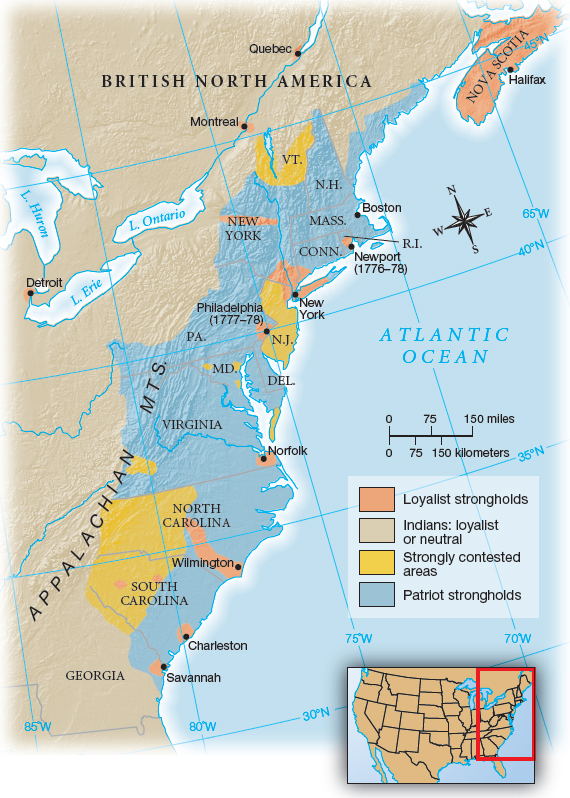The Loyalists
Printed Page 186
Section Chronology
Around one-fifth of the American population remained loyal to the crown in 1776, and another two-fifths tried to stay neutral, providing a strong base for the British. In general, loyalists believed that social stability depended on a government anchored by monarchy and aristocracy. They feared that democratic tyranny was emergent among the self-styled patriots who appeared to be unscrupulous, violent men grabbing power for themselves. Pockets of loyalism thus existed everywhere (Map 7.2).

loyalists
 Colonists who remained loyal to Britain during the Revolutionary War, probably numbering around one-fifth of the population in 1776. Colonists remained loyal to Britain for many reasons, and loyalists could be found in every region of the country.
Colonists who remained loyal to Britain during the Revolutionary War, probably numbering around one-fifth of the population in 1776. Colonists remained loyal to Britain for many reasons, and loyalists could be found in every region of the country.
Even New England towns at the heart of the turmoil, such as Concord, Massachusetts, had a small and increasingly silenced core of loyalists. On occasion, husbands and wives, fathers and sons disagreed completely on the war.
Who Were the Loyalists??
> Who Were the Loyalists??
- Royal officials, such as governors, local judges, and customs officers
- Wealthy merchants
- Conservative urban lawyers
- People who already disliked pro-Revolution citizens, such as many backcountry Carolina farmers who resented the power of the pro-Revolution gentry
- Southern slaves who looked to Britain in hope of freedom
- Many Indian tribes
Many Indian tribes chose neutrality at the war’s start, seeing the conflict as a civil war between the English and the Americans. Eventually, however, they were drawn in, most taking the British side. One young Mohawk leader, Thayendanegea (known also by his English name, Joseph Brant), traveled to England in 1775 to complain to King George about land-hungry New York settlers. “It is very hard when we have let the King’s subjects have so much of our lands for so little value,” he wrote; “they should want to cheat us in this manner of the small spots we have left for our women and children to live on.” Brant pledged Indian support for the king in exchange for protection from encroaching settlers. In the Ohio Country, parts of the Shawnee and Delaware tribes started out pro-American but shifted to the British side by 1779 in the face of repeated betrayals by American settlers and soldiers.
Loyalists were most vocal between 1774 and 1776, when the possibility of a full-scale rebellion against Britain was still uncertain. They challenged the emerging patriot side in pamphlets and newspapers. In 1776 in New York City, 547 loyalists signed and circulated a broadside titled “A Declaration of Dependence” in rebuttal to the congress’s July 4 declaration, denouncing the “most unnatural, unprovoked Rebellion that ever disgraced the annals of Time.”